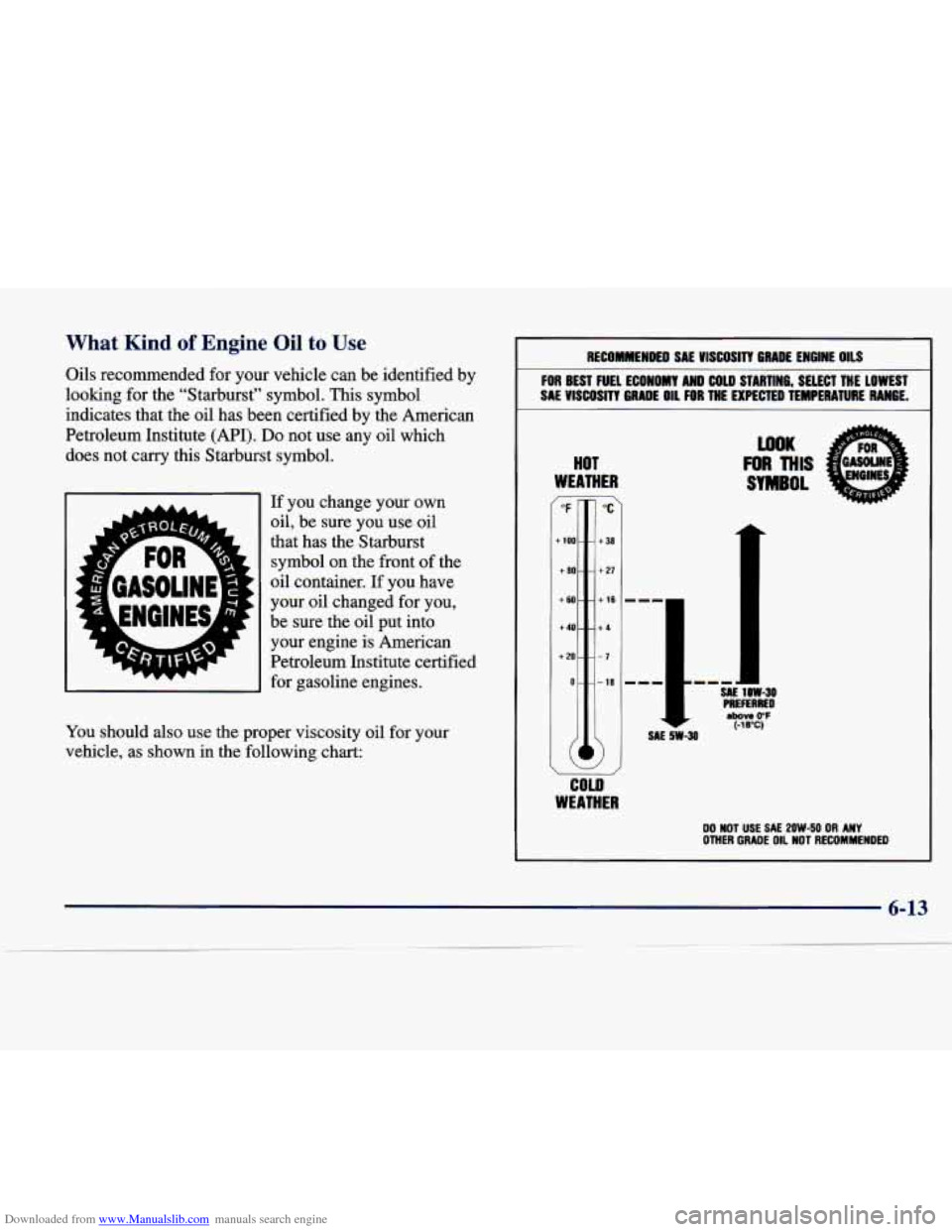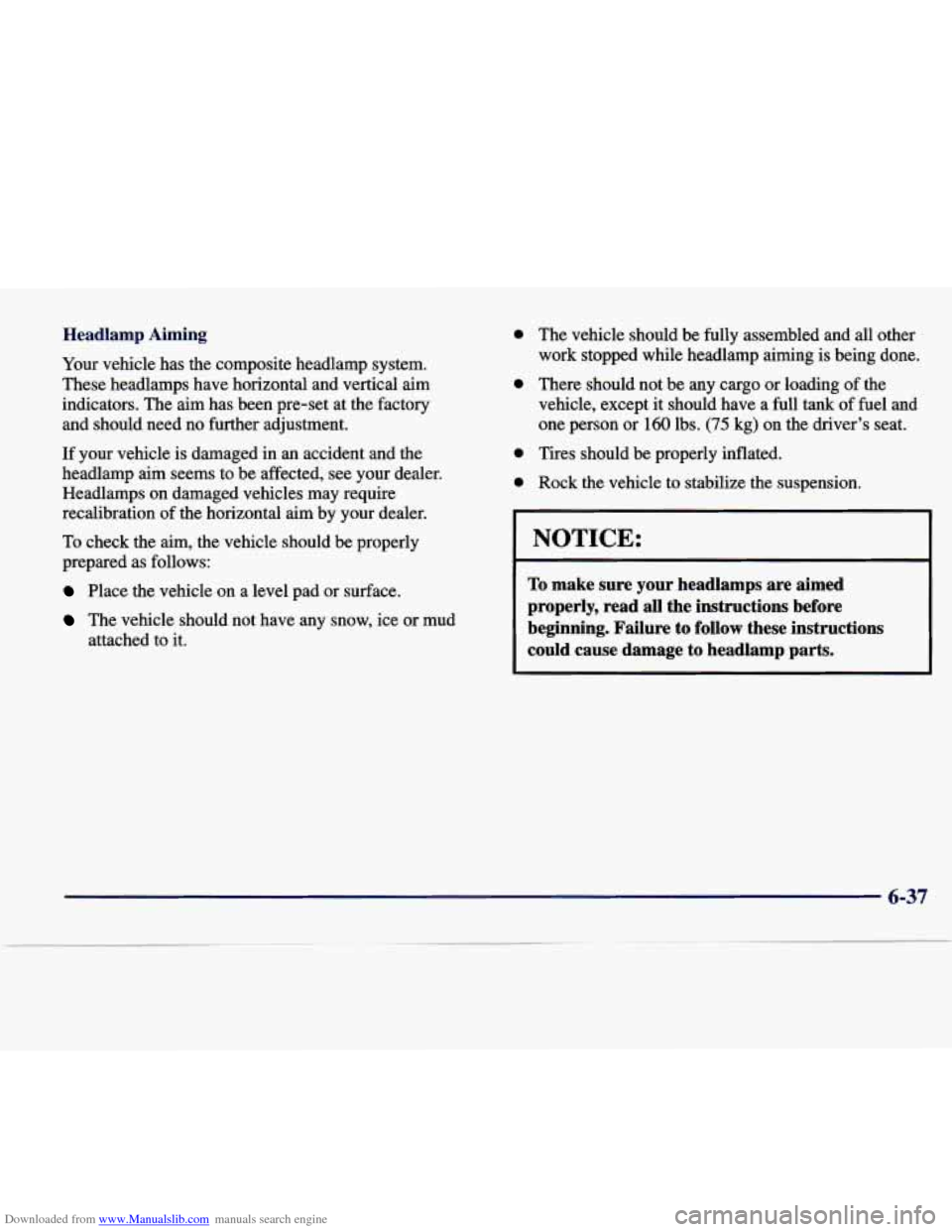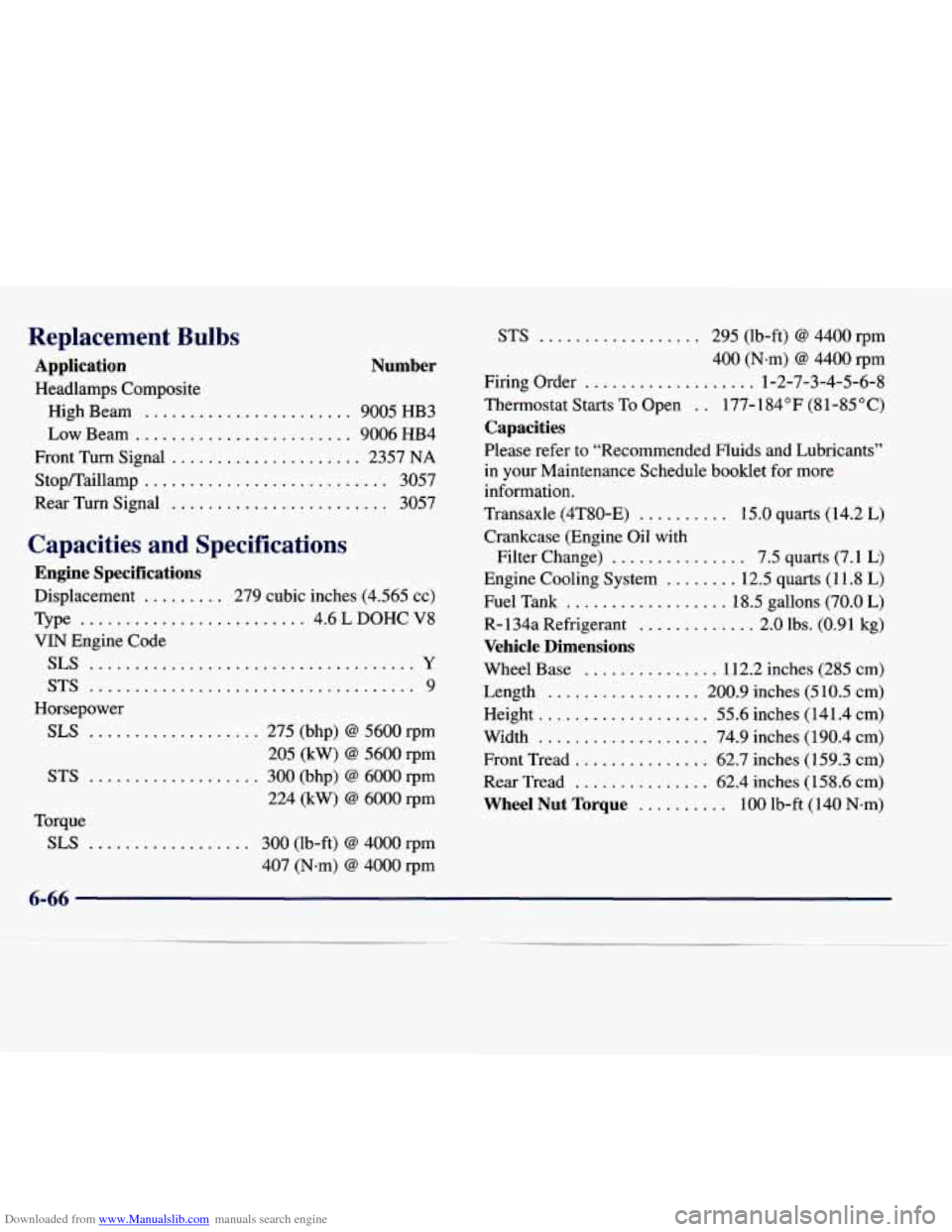Page 288 of 378

Downloaded from www.Manualslib.com manuals search engine What Kind of Engine Oil to Use
Oils recommended for your vehicle can be identified by
looking for the "Starburst" symbol. This symbol
indicates that the oil has been certified by the American
Petroleum Institute
(API). Do not use any oil which
does not carry this Starburst symbol.
If you change your own
oil, be sure you use oil
that has the Starburst
symbol on the front
of the
oil container. If you have
your oil changed for you,
be sure the oil put into
your engine is American
Petroleum Institute certified
for gasoline engines.
You should also use the proper viscosity oil for your
vehicle, as shown in the following chart:
RECOMMENDED SAE VISCOSITY GRADE ENGINE OILS
FOR BEST FUEL ECONOMY AND COLD STARTING, SELECT ME LOWEST
SA€ VISCOSITY GRADE OIL FOR THE EXPECTED TEMPERATURE RANGE.
HOT
WEATHER I
"F
c 100-
+ 80 '
+ 60.
+40.
+ 20 -
0-
7
7 "C
+ 38
+ 27
+ 16
+4
-7
- 18 111 SAE I law-30
PREFERRED .bow 0°F (-1 eoC)
WOK
FOR THIS
SYMBOL
WEATHER
DO NOT USE SAE 2OW-50 OR ANY OTHER GRADE OIL NOT RECOMMENDED
- 6-13
Page 312 of 378

Downloaded from www.Manualslib.com manuals search engine Headlamp Aiming
Your vehicle has the composite headlamp system.
These headlamps have horizontal and vertical aim indicators. The aim has been pre-set at the factory
and should need no further adjustment.
If your vehicle is damaged
in an accident and the
headlamp aim seems to be affected, see your dealer. Headlamps on damaged vehicles may require recalibration of the horizontal aim by your dealer.
To check the aim, the vehicle should be properly
prepared as follows:
Place the vehicle on a level pad or surface.
The vehicle should not have any snow, ice or mud
attached to it.
0
0
0
0
The vehicle should be fully assembled and all other
work stopped while headlamp aiming is being done.
There should not be any cargo or loading
of the
vehicle, except it should have a full tank of fuel and
one person or
160 lbs. (75 kg) on the driver’s seat.
Tires should be properly inflated.
Rock the vehicle to stabilize the suspension.
NOTICE:
To make sure your headlamps are aimed
properly, read all the instructions before
beginning. Failure to follow these instructions
could cause damage to headlamp parts.
Page 318 of 378

Downloaded from www.Manualslib.com manuals search engine Example:
You’ll find maximum load and inflation pressure
molded on the tire’s sidewall, in small letters, near the
rim flange. It will read something
like this: Maximum
load
690 kg (1521 lbs.) @ 300 kPa (44 psi) Max. Press.
For this example, you would set the inflation pressure
for high-speed driving at
38 psi (265 kPa).
NOTICE:
Don’t let anyone tell you that underinflation or
overinflation is
all right. It’s not. If your tires
don’t have enough
air (underinflation), you can
get the following:
4) Too much flexing
4) Too much heat
4) Tire overloading
Bad wear
Bad handling
a Bad fuel economy.
NOTICE: (Continued)
I NOTICE: (Continued)
If your tires have too much air (overinflation),
you can get the following:
Unusual wear
Bad handling
Rough ride
0 Needless damage from road hazards.
When
to Check
Check your tires once a month or more.
Don’t forget your compact spare tire. It should be at
60 psi (420 Pa).
How to Check
Use a good quality pocket-type gage to check tire
pressure. You can’t
tell if your tires are properly inflated
simply by looking at them. Radial tires may
look
properly inflated even when they’re underinflated.
Be sure to put the valve caps back on the valve stems.
They help prevent leaks by keeping out
dirt and moisture.
6-43
Page 331 of 378

Downloaded from www.Manualslib.com manuals search engine Sheet Metal Damage
If your vehicle is damaged and requires sheet metal
repair or replacement, make sure the body repair shop applies anti-corrosion material to the parts repaired or
replaced to restore corrosion protection. At least every
spnng, flush these materials from the
underbody with plain water. Clean any areas where mud
and other debris can collect. Dirt packed in closed areas
of the frame should be loosened before being flushed.
Your dealer or an underbody car washing system can do
this for you.
Fil Jamage
Any stone chips, fractures or deep scratches in the finish
should be repaired right away. Bare metal will corrode
quickly and may develop into
a major repair expense.
Minor chips and scratches can be repaired with touch-up
materials available from your dealer or other service outlets. Larger areas
of finish damage can be corrected
in your dealer’s body and paint shop.
Underbody Maintenance
Chemicals used for ice and snow removal and dust
control can collect on the underbody.
If these are not
removed, accelerated corrosion (rust) can occur on the underbody parts such as fuel lines, frame, floor pan
and exhaust system even though they have
corrosion protection.
Chemical Paint Spotting
Some weather and atmospheric conditions can create a
chemical fallout. Airborne pollutants can fall upon and
attack painted surfaces on your vehicle. This damage
can take two
forms: blotchy, ringlet-shaped
discolorations, and small irregular dark spots etched into
the paint surface.
Although no defect in
the paint job causes this, Cadillac
will repair, at no charge to the owner, the surfaces of
new vehicles damaged by this fallout condition within
12 months or 12,000 miles (20 000 km) of purchase,
whichever occurs first.
6-56
Page 338 of 378
Downloaded from www.Manualslib.com manuals search engine Rear Underseat Bussed Electrical Center (BEC)
1631
The rear BEC is located beneath the rear seat on the
driver’s side. The rear seat cushion must be removed to
access the
BEC. See “Removing the Rear Seat Cushion”
in the Index.
Minifuses
Fuse Usage
1 Fuel Pump
2 Heater, Ventilation, Air Conditioner Blower
3 Memory Seat, Tilt and Telescoping Steering
4 Assembly Line Diagnostic Link
5 Driver Door Module
6 Heated Seat Left Rear
6-63
Page 339 of 378
Downloaded from www.Manualslib.com manuals search engine Fuse
7
8
9
10
11
12
13
14 15
16
17
18
19
20
21
22
23
Usage
Power Tilt and Telescoping Steering Supplemental Inflation Restraint
Not Used
Lamps
Park Right
Fuel Tank Ventilation Solenoid
Ignition
1
Lamps, Parking Left
Interior Lamp Dimmer Module
Navigation
- Export Only
Heated Seat Left Front
Export Lighting
Rear Door Modules
Stoplamps
Neutral Safety Back-up
Audio
Retained Accessory Power for Sunroof
Not Used
Fuse
24
25
26
27
28
29
30
31
32
33
34
35
36
37
38
Usage
Not Used
Passenger Door Module
Fuel Door/Trunk Release
Interior Lamps
Rear HVAC Blower
Ignition Switch
Not Used Heated Seat Right Front
Continuous Variable Road Sensing
Suspension
Heating, Ventilation, Air Conditioning
Ignition
3 Rear
Antilock Braking System
Turn SignaVHazard Heated Seat Right Rear
Dash Integration Module
6-64
Page 340 of 378
Downloaded from www.Manualslib.com manuals search engine Micro Relays Relay
39
40 41
42
43
44
45
46
47
48
49
50
51
52
53
54
55
Usage
Fuel Pump
Parking Lamps Ignition
1
Park Brake A
Park Brake B
Park Shift Interlock
Reverse Lamps
Retained Accessory Power for Sunroof
Rear HVAC Blower
CVRSS Dampers
Ignition
3
Fuel Tank Door Release
Interior Lamps
Trunk Release
Front Courtesy Lamps
Rear Courtesy Lamps
Electronic Level Control Compressor
Circuit Breakers
Relay Usage
56 Power Seats
57 Power Windows
Mini Relays
Relay Usage
58 Cigarette Lighter
59 Rear Defog
Maxifuses Fuse Usage
60 Park Brake
61 Rear Defog
62 Not Used
63 Audio Amplifier
64 ELC CompressorExhaust
65 Cigar Lighter
66 Not Used
The spare fuses are located in numbers
67 through 74.
The fuse puller is located in number 75.
6-65
Page 341 of 378

Downloaded from www.Manualslib.com manuals search engine Replacement Bulbs
Application Number
Headlamps Composite High Beam
....................... 9005 HB3
Low Beam ........................ 9006 HB4
Front Turn Signal ..................... 2357 NA
Stop/Taillamp ........................... 3057
Rear Turn Signal
........................ 3057
Capacities and Specifications
Engine Specifications
Displacement ......... 279 cubic inches (4.565 cc)
Type
......................... 4.6 L DOHC V8
VIN Engine Code
SLS .................................... Y
STS .................................... 9
Horsepower
SLS ................... 275 (bhp) @ 5600 rpm
STS
................... 300 (bhp) @ 6000 rpm
205 (kW)
@ 5600 rpm
224 (kW)
@ 6000 rpm
Torque
SLS .................. 300 (lb-ft) @ 4000 rpm
407 (N-m)
@ 4000 rpm STS
.................. 295 (lb-ft) 63 4400 rpm
Firing Order
................... 1-2-7-3-4-5-6-8
400
(N-m)
@ 4400 rpm
Thermostat Starts To Open
, , 177- 184°F (8 1-85 “C)
Capacities
Please refer to “Recommended Fluids and Lubricants”
in your Maintenance Schedule booklet for more
information.
Transaxle
(4T80-E) .......... 15.0 quarts (14.2 L)
Crankcase (Engine Oil with Filter Change)
............... 7.5 quarts (7.1 L)
Engine Cooling System ........ 12.5 quarts (1 1.8 L)
R- 134a Refrigerant ............. 2.0 lbs. (0.9 1 kg)
Vehicle Dimensions
Wheel Base ............... 112.2 inches (285 cm)
Length
................. 200.9 inches (510.5 cm)
Height
................... 55.6 inches (141.4 cm)
Width
................... 74.9 inches (190.4 cm)
Front Tread
............... 62.7 inches (1 59.3 cm)
Rear Tread
............... 62.4 inches (158.6 cm)
Wheel Nut Torque .......... 100 lb-ft (140 N-m)
Fuel Tank
.................. 18.5 gallons (70.0 L)
6-66